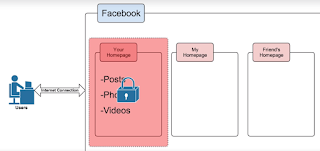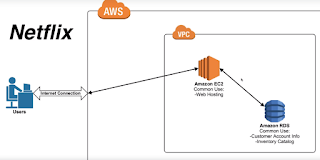AWS core concepts
In this blog spot I am mainly focusing on the simplified AWS architecture. Before going deeper in this topic it is very important to understand the main frame of the subject
This caption is taken from UDEMY. As in the above picture, there are several main components.
1. VPC
2. Amazon EC2 server
3. Amazon RDS
4. Users
VPC
stands for Virtual Private Cloud. To get understand the that thing refer below example. Take Facebook as an example. Consider your face book account. In there you can add Posts, Photos, videos and etc. And also you can set privacy for that. Which means you can set parties that your post needed to be seen and allow them to see your post.
stands for Virtual Private Cloud. To get understand the that thing refer below example. Take Facebook as an example. Consider your face book account. In there you can add Posts, Photos, videos and etc. And also you can set privacy for that. Which means you can set parties that your post needed to be seen and allow them to see your post.
So as same as in the above example, AWS works as same.
Amazon RDS is the database platform that is provided by the AWS. It contains all the details related to the application. When requests comes to that related information back to the EC2 instance and then it directs to the browser(User).
So, VPC
is your private cloud of AWS. There you can place your AWS content, resources and also you can allow or restrict (Setting the accessibility) for them.
Amazon EC2 server(EC2 Instance)
Theoretically its a server computer. As same as other computers basically it has CPU, Operating System(Windows or Linux), Hard-Drive, Network Card, Firewall for security purpose and RAM.
For example you can go to the home page of Netflix (Netflix using the AWS resources). In that case AMAZON EC2 instance works as a web hosting server. It contains all the resources such as codes and files which are needed to be displayed the web page.
So simply the EC2 instance is basically a virtual computer that can be used it for what ever you can use for your purpose.
Amazon RDS
Cloud terminologies
1. Scalability
2. Elasticity
3. High Availability
4. Fault Tolerance
When increase of the users may be crashed the AWS EC2 instance. Because all the requests are coming through via that. In order to avoid that AWS has introduced the creating new instances of the EC2 server. Then the new users can be logged in to those. So that is called the Scalability.
Created instances are no longer used, AWS can remove those EC2 instances. It is called Elasticity.
High Availability means, any one can access to the EC2 server from anywhere.
When a one created instance is crashed for any reason, all the users cannot be able to log in to that server any more. So AWS designed to direct that bunch of users to other working EC2 instance. So the load of that server going to be doubled. Actually it is not the problem with the AWS because most of the times AWS allows that. Once that load directed to a other server, AWS creates a new EC2 instance instead of the crashed one. After creating it, the previous bunch of users are re-directed to the newly created instance. So that is called fault- Tolerance.
So the Basic things related to the AWS is covered from this and we can dive more deeper on AWS from next posts inwards.







No comments:
Post a Comment